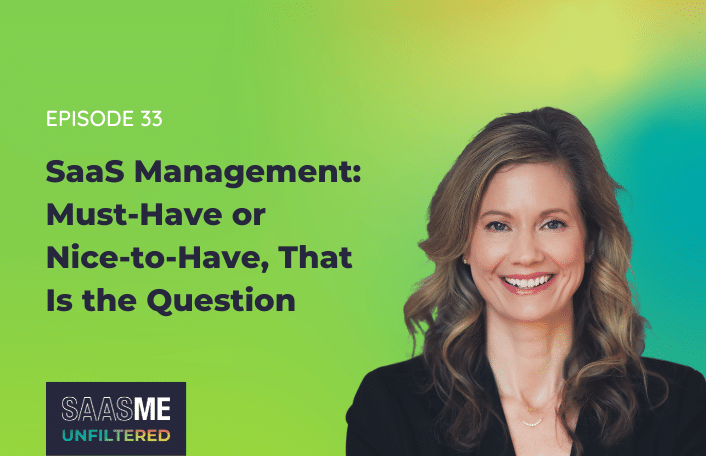08/24/2023
Table of Contents
If you’re wondering whether SaaS management is a must-have or nice-to-have, you’re not alone. As we look back at our guests from the past few seasons, each one has had a unique journey finding the answer for themselves. In this episode, we’ve compiled some of our favorite SaaSMe Unfiltered moments – stories of stumbling through “oh shit” moments, building a business case and how SaaS management became a priority.
Episode Summary
When we started the show last spring, we set out to capture the inspiring stories of people taking back control of their SaaS portfolio and spend, mitigating risk, and driving innovation and efficiency at their organizations. We hope that hearing from these IT, software asset management, and procurement leaders has been helpful to you as you navigate your own SaaS management journey.
In this episode, we’ve pulled together some of our favorite SaaSMe Unfiltered moments with thoughts from past guests on:
- Why managing SaaS is so hard
- Making the business case for SaaS management
- Establishing SaaS management as an ongoing program
- Why a tool is mission-critical to your success
Guest Spotlight
This episode highlights past guests – folks in IT, software asset management, procurement, security and finance.
- Karen Hodson, Global Procurement & Real Estate Officer at Marigold
- Lindsay Stokes, IT Asset Manager at Netflix
- Jason Owens, Sr. Director, Asset Management at Salesforce
- Chris Asing, VP and Head of IT, Real Estate & Procurement at Redis
- David Stoicescu, Chief Information Security Officer at Deepwatch
- Russell Lester, Chief Financial Officer at Versapay
- Gordon Atkin, VP, Technology & Business Platforms at Salsify
Episode Highlights
Spreadsheets Don’t Cut It, You Need to Ditch Them
We hear time and again from companies managing their SaaS applications in a spreadsheet. Sure, it’s a way to start. But if you’re using one today, you know it’s only as accurate as the data you put in, and, let’s face it, it’s often out of date.
“It’s a lot of pulling information together, trying to figure out what’s going on and who owns it in the company, so that we can get some background,” said Karen Hodson, Global Procurement & Real Estate Officer at Marigold. “The challenge is, inevitably, the moment you create those spreadsheets, they become outdated.”
Marigold also had a lot of M&A activity over the years, which tends to “blow up every spreadsheet you have.” That led Hodson to explore a tool that could make this process easier.
“Having a tool gives you that holistic view of comparison of are you already spending money on the same, similar type tool? If so, how much are you spending? Who’s the owner of that? Let’s take a look and do a deeper dive there,” said Hodson. “And then also, benchmarking information when you’re trying to expand.”
Lack of Visibility Prevents Data-Driven Decision Making
Before kicking off Netflix’s SaaS management journey, ITAM leader Lindsay Stokes and her team didn’t understand the full scale of their SaaS problem.
“Shortly after talking to a lot of the stakeholders in this whole process, there’s really hardly any data. There’s disparate tracking, a lack of resources, and no standard process across the board,” said Stokes.
This lack of visibility was in part due to the company’s governance approach – where employees can get whatever tool they need to do their jobs.
“With Netflix’s mission to entertain the world, we don’t like the idea of putting guardrails, preventing any employees from creating great content because they don’t have the software they need to do their job,” explained Stokes. “You can imagine with this model, the SaaS sprawl.”
Ultimately, this moment was pivotal in helping Stokes kick off Netflix’s SaaS management journey. And getting visibility first was key. As Stokes put it, “How could we make informed decisions about what’s best for Netflix without data to tell the story?”
“Oh Shit” Moment Helps Build the Case for SaaS Management
We’ve had quite a few guests on the show who have shared what we like to call “oh shit” moments. Or that moment when they realized they needed SaaS management. For Jason Owens, the Enterprise SAM/ITAM Program Owner at Salesforce, that moment was when he discovered something surprising and costly happening right under his nose.
It was his first year on the job, and Owens was managing the renewal for an audio-visual editing platform. To his surprise, all 100 employees in the sales organization were using this tool to edit cat pictures and videos.
Owens shared, “I’m thinking, ‘Oh, geez. We’re having a mid-six figures overage, plus a million plus and forward-looking true up, and we’re in trouble. I’m in trouble.’”
If there was a moment to turn lemons into lemonade, this was it. Owens and his boss turned the conversation into a business case for SaaS management.
“This is where if we have a discovery platform, if we implement governance, we can, one, avoid these things,” said Owens, “but also unlock that money that we would have to spend on that for investment in transformative business processes and platforms.”
You Need One System for SaaS Inventory and Optimization Insights
When you don’t have one place to store all the information – a central source of truth – you can’t uncover the trouble spots and find areas for improvement. For Chris Asing, Head of IT at Redis, using a SaaS Management Platform has been critical to achieving ongoing visibility and optimization.
“You have to have the data. And then there’s trying to make intelligent, or at least, sensible conclusions about that data and making those connections. Starting with that is key.”
In the past, knowing what you’re consuming and paying for was a big struggle. A SaaS management platform ended up being the missing piece for Asing.
“It’s been having that data, drawing on conclusions and categorizations and insights that the platform has provided with us,” said Asing. “Then on our own terms, figuring out what’s important for us.”
Asing went on to say that you need to commit to using one system versus multiple systems. “[As a result], we’ve been able to really understand our portfolio. We know what we have right now. We know where we’re duplicative.”
SaaS Management Is for All Sizes of Companies; Start Early
While the stories we’ve shared so far are from enterprise organizations, SaaS is a challenge for companies of ALL sizes. According to David Stoicescu, the Chief Information Security Officer at Deepwatch, starting a SaaS management program early gives you a head start.
Stoicescu knows from experience, having first implemented a program at a company with around 30 employees.
“I was already starting to think at the back of my mind, how do we make sure that we don’t run into that problem several years from now?” said Stoicescu. “It’s not that difficult to manage the mischief at a small scale when you know all the employees by name.”
When you build that muscle early, you have the entire company bought into SaaS management from the beginning. That leaves fertile ground for a more effective program as you scale.
Finance Has an Opportunity to Be the Hero with SaaS Management
We’re seeing more and more the role of the CFO becoming a trusted advisor across the organization. They are driving alignment across the company, empowering their IT peers, and driving impactful change. With operating expense reduction being a key initiative for many companies, having your CFO on board can make or break your SaaS management program.
According to Russell Lester, CFO at Versapay, Finance has “an opportunity to be the hero, to identify where there’s leakage or wastage in the system.”
Between the massive wave of tooling the last few years and best-of-breed approach, many organizations have what Lester calls a blast radius of tools all over the place. But that’s where the Finance team has a chance to shine.
“The Finance team can be the tip of the spear, helping the company see where there’s overlap, helping to rationalize the footprint, the technology footprint in partnership with other parts of the company,” said Lester.
Build a Successful SaaS Management Program with These Key Components
A common theme throughout this episode is that visibility is foundational to SaaS management. But it goes beyond having a central source of truth for your SaaS inventory; it also requires a focus on license and renewal management.
Gordon Atkin, today the VP, Technology & Business Platforms at Salsify, has experience building SaaS management programs going back to 2014. To begin, he says, “You’ve got to get your arms around the complete inventory.
Before going through the discovery process, Atkin expected to have around 150 applications. The reality? There were actually 350 applications in their stack.
“Once you have that together,” said Atkin, “you need to understand total spend and utilization against that spend.”
Next, focus on optimization. Atkins recommends getting license utilization at least 95%. Then, address your renewals and consolidate redundant applications.
Last but not least, benchmarking is critical. “Because you want to know if you’re spending a million dollars on Salesforce, is that high, medium, or low, compared to others that are of similar size or have a similar footprint?”
SaaS Management Is A Must-Have
Gordon mentioned using a spreadsheet in the early days to track and manage SaaS – something we also heard from Karen Hodson at Marigold. So, what’s the criticality of using a tool instead?
To me, SaaS management is a must have… It’s the number two spend in especially SaaS companies. For more traditional legacy or on-premise companies, it’s going to be a cost that continues to creep up.”
While a spreadsheet covers the bare minimum, it’s not scalable and quickly out-of-date. Not to mention “traditional software asset tracking solutions aren’t going to help you manage [SaaS].”
Check out other episodes here, Apple Podcasts, Spotify, or wherever you listen to podcasts.
ABOUT THE AUTHOR

Meredith Albertson
As Chief Marketing Officer, Meredith leads the marketing team to drive Zylo’s strategic growth and cement its position as the SaaS Management leader. She brings more than 20 years of sales, product and marketing experience. Meredith was also named a 2021 Bronze Stevie Award Winner – Female Executive of the Year. Prior to Zylo, Meredith was Chief Marketing Officer at Stratifyd, an experience analytics platform powered by AI, and VP, Marketing at Tealium, an industry-leading customer data platform.

